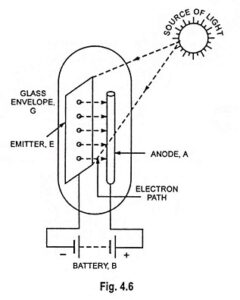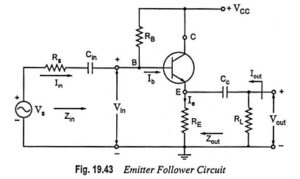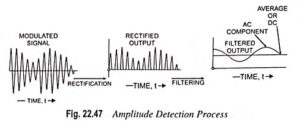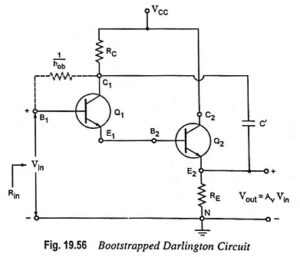Operation and Power Control of Cellular Systems:
In this section, let us describe the operation of the cellular mobile system from a customer’s perception without touching on the design parameters. The operation can be divided into four parts and a handoff procedure.
Mobile Unit Initialization : When a user sitting in a car activates the receiver of the mobile unit, the receiver scans 21 set-up channels which are designated among the 416 channels. It then selects the strongest and locks on for a certain time. Since each site is assigned a different set-up channel, locking onto the strongest set-up channel usually means selecting, the nearest cell site. This self-location scheme is used in the idle stage and is user-independent. It has a great advantage because it eliminates the load on the transmission at the cell site for locating the mobile unit. The disadvantage of the self-location scheme is that no location information of idle mobile units appears at each cell site. Therefore, when the call initiates from the land line to a mobile unit, the paging process is longer. Since a large percentage of calls originates at the mobile unit, the use of self-location schemes is justified. After 60’s the self-location procedure is repeated. In the future, when landline originated calls increase, feature called “registration” can be used.
Mobile Originated Call : The user places the called number into an originating register in the mobile unit, checks to see that the number is correct, and pushes the “send” button. A request for service is sent on a selected set-up channel obtained from self-location scheme. The cell site receives it, and in directional cell sites, selects the best directive antenna for the voice channel to use. At the same time the cell site sends requisite to the mobile telephone switching office (MTSO) via a highspeed data link. The MTSO selects an appropriate voice channel for the call, and the cell site acts on it through the best directive antenna to link the mobile unit. The MTSO also connects the wireline party through the telephone company zone office.
Network Originated Call : A landline party dials a mobile unit number. The telephone company zero office recognize that the number is mobile and forward the cell to the MTSO. The MTSO sends a paging message to certain cell sites based on the mobile unit number and the search algorithm. Each cell site transmits the page on its own set-up channel, locks onto it, and responds to the cell site. The mobile unit also follows the instruction to tune to an assigned voice channel and initiate user alert.
Call Termination : When the mobile user turns off the transmitter, a particular signal (signaling tone) transmits to the cell site, and both sides free the voice channel. The mobile unit resumes monitoring pages through the strongest set-up channel.
Handoff Procedure : During the call, two parties are on a voice channel. When the mobile unit moves out of the coverage area of a particular cell site, the reception becomes weak. The present cell site requests a handoff. The system switches the call to a new frequency channel in a new cell site without either interrupting the call or alerting the near. The call continues as long as the user is talking. The user does not notice the handoff occurrences. Handoff was first used by the AMPS system, them renamed handover by the European systems because the different meanings in English and American English.
Power Control of Cellular Systems:
The power level can be controlled only by the mobile transmitted switching office (MTSO), not by the mobile units, and there can be only limited power control by the cell sites as a result of system limitations. The reasons are as under :
The mobile transmitted power level assignment must be controlled by the MTSO or the cell site, not the mobile unit. Or, alternatively, the mobile unit can lower the power level but cannot arbitrarily increase it. This is because the MTSO is capable of monitoring the performance of the whole system and can increase or decrease the transmitted power level of those mobile units to render optimum performance. The MTSO will also optimize performance for any particular mobile unit unless a special arrangement is made.
Function of the MTSO:
The MTSO controls the transmitted power levels at both the cell sites and the mobile units. The advantages of having the MTSO control of power levels are as under :
(i) Control of the mobile transmitted power levels. When the mobile unit is approaching the cell site, the mobile unit power level must be reduced for the following factors:
- Reducing the chance of generating intermodulation products from a saturated receiving amplifier.
- Lowering the power level is equivalent to reducing the chance of interfering with other channel cell sites.
- Reducing the near-end-far end interference ratio.
(ii) Control of the cell-site transmitted power level. When the signal received from the mobile unit at the cell site is quite strong, then MTSO must reduce the transmitted power level of that particular radio at the cell site and also at the same time, lower the transmitted power level at the mobile unit. The advantages are as under :
- For a particular radio channel, the cell site decreases significantly, the cochannel reuse distance increases, and the cochannel interference is further reduced, In other words, cell size and cochannel interferences are inversely proportional to cochannel reuse distance.
- The adjacent channel interference in the system is also reduced. However, in most power control of cellular systems, it is not possible to reduce only one or a few channel power levels at the cell site due to of the design limitation of the combiner. The channel isolation in the combiner is 18 dB. If the transmitted power level of one channel is lower, the channel having high transmitted design an unequal-power combiner for the system operator so that the power level of each channel can be controlled at the cell site.
(iii) The power transmitted from a small cell is always reduced, and so is that from a mobile unit. The MTSO can facilitate adjustment of the transmitted power of the mobile units as soon as they enter the cell boundary.






